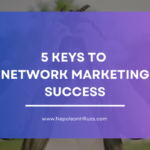Introduction
Network marketing has become a popular way for people to build a business and achieve financial freedom. However, there are two distinct approaches to network marketing: active prospecting and passive marketing. Understanding the difference between these two methods is crucial to achieving success in the industry.
Active prospecting involves actively seeking out potential customers and recruits, while passive marketing involves creating content and using social media to attract potential leads. Both approaches have their advantages and disadvantages, and the right one for you depends on your personality, goals, and circumstances.
In this article, we’ll dive deeper into the differences between active prospecting and passive marketing, explore their pros and cons, and provide you with the information you need to choose the best approach for your network marketing business.
Active Prospecting: What Is It and How Does It Work?
Active prospecting is the process of directly reaching out to potential customers or recruits through various methods, such as cold calling, door-to-door sales, and in-person events. Here’s what you need to know about active prospecting:
- Active prospecting requires a significant amount of time and effort. You need to be willing to put in the work to build relationships with potential customers and recruits.
- Active prospecting is more effective for those who have strong interpersonal skills. You need to be comfortable with approaching strangers and engaging in conversation.
- Active prospecting can be more challenging in today’s digital age, as people are more guarded about their personal information and more likely to ignore cold calls and door-to-door salespeople.
Passive Marketing: What Is It and How Does It Work?
Passive marketing involves creating content and using social media to attract potential leads. Here are some key points about passive marketing:
- Passive marketing requires a lot of upfront effort in creating content such as blog posts, videos, or podcasts. You must also build a strong social media presence to attract potential leads.
- Passive marketing is more effective for those who have strong online marketing skills. You need to understand how to create content that is engaging and relevant to your audience.
- Passive marketing can take time to gain traction, but once it does, it can be a powerful way to attract leads without constantly hustling for them.
Active Prospecting vs. Passive Marketing: Pros and Cons
Now that we’ve covered the basics of active prospecting and passive marketing let’s take a closer look at their advantages and disadvantages.
Active Prospecting: Pros
- Active prospecting allows you to build relationships with potential customers and recruits. By talking to people face-to-face or over the phone, you can establish trust and credibility.
- Active prospecting is more immediate in terms of results. If you’re good at sales and can effectively persuade people, you can see results quickly.
- Active prospecting allows you to identify potential leads that you might not find through passive marketing.
Active Prospecting: Cons
- Active prospecting requires more time and effort. You need to be willing to put in the work to build relationships and convert leads into customers or recruits.
- Active prospecting can be uncomfortable for some people. It requires you to approach strangers and engage in conversation, which can be intimidating.
- Active prospecting can be less effective in today’s digital age. Many people are more guarded about their personal information and more likely to ignore cold calls and door-to-door salespeople.
Passive Marketing: Pros
- Passive marketing allows you to attract leads without constantly hustling for them. Once you’ve created your content and established a strong social media presence, potential leads can come to you without much additional effort.
- Passive marketing is less intrusive than active prospecting. By creating valuable content and sharing it on social media, you’re providing value to potential leads without being pushy or aggressive.
- Passive marketing can be more effective in reaching a broader audience. By creating content that is shareable and relevant, your message can spread to more people than you would reach through active prospecting.
Passive Marketing: Cons
- Passive marketing requires a lot of upfront effort. You need to be willing to put in the time and effort to create valuable content and build a strong social media presence.
- Passive marketing takes time to gain traction. Unlike active prospecting, which can provide immediate results, passive marketing requires patience and consistency.
- Passive marketing can be challenging to measure. It’s difficult to determine exactly how many leads or sales are generated directly from your content and social media efforts.
Which Approach Is Right for You?
Now that we’ve explored the pros and cons of active prospecting and passive marketing, how do you decide which approach is right for you? Here are some key factors to consider:
- Personality: Are you comfortable approaching strangers and engaging in conversation, or do you prefer to build relationships through content and social media?
- Skills: Do you have strong interpersonal skills that would make you effective at active prospecting, or are your strengths in creating content and engaging on social media?
- Time: How much time do you have to dedicate to your network marketing business? Active prospecting requires more time and effort, while passive marketing requires more upfront effort in content creation and social media management.
- Goals: What are your goals for your network marketing business? If you’re looking for quick results, active prospecting may be the better choice. If you’re looking for a long-term, sustainable approach, passive marketing may be more effective.
Ultimately, the decision between active prospecting and passive marketing depends on your unique circumstances and goals. It’s possible to combine both approaches, using active prospecting to identify potential leads and passive marketing to attract them over time.
FAQs
Q: Is one approach better than the other? A: Neither approach is inherently better than the other. The right approach for you depends on your personality, skills, and goals.
Q: Can I use both approaches simultaneously? A: Yes, you can combine active prospecting and passive marketing to create a comprehensive approach to building your network marketing business.
Q: How long does it take for passive marketing to work? A: Passive marketing takes time to gain traction, and the results can vary depending on your content and social media strategy. However, with consistent effort and high-quality content, you can begin to see results within a few months.
Conclusion
Active prospecting and passive marketing are two distinct approaches to network marketing, each with its own advantages and disadvantages. By understanding the differences between the two approaches and considering your personality, skills, and goals, you can determine which one is the best fit for your network marketing business.
Remember, there is no one-size-fits-all solution to network marketing. What works for one person may not work for another. The key is to be willing to try different approaches and strategies until you find what works for you.

To Our Unlimited Success!

P.S. Want to make money online? Click here to get my 100% Free Course and learn How ANYONE Can Launch the #1 Beginner Friendly Online Business from Home!!
P.P.S If you found value on my website, your support is greatly appreciated, feel free to buy me a coffee by clicking here!





